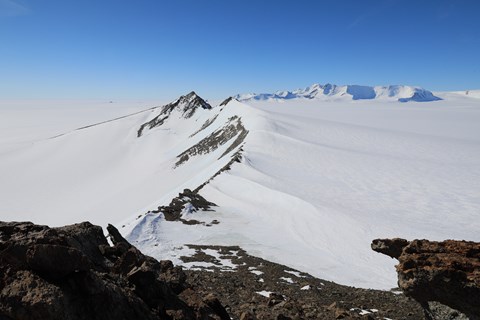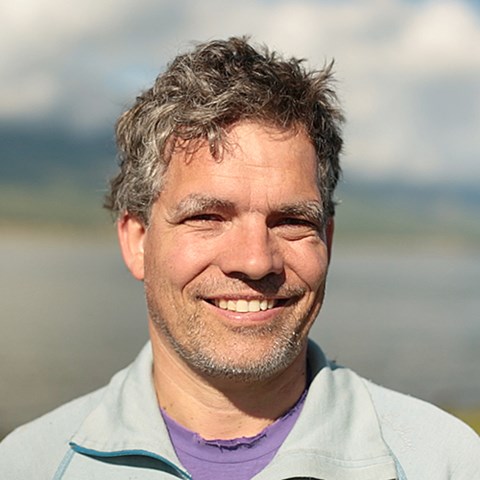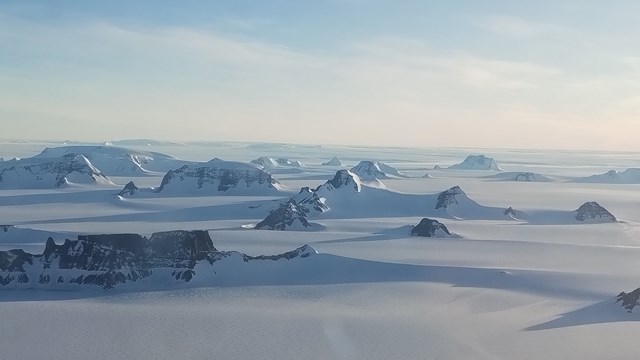Time for a new Swedish Antarctic expedition
 Researchers on top of Vardeklettane in Antarctica during MAGIC-DML 2016/17. Photo: Ola Eriksson
Researchers on top of Vardeklettane in Antarctica during MAGIC-DML 2016/17. Photo: Ola Eriksson
During this year's Antarctic expedition DML 2023/24, which the Swedish Polar Research Secretariat organises, a project is participating where the researchers seek to answer how Antarctica will develop in a future with a warmer climate. Part of the answer lies in the bedrock and erratics deposited by the ice sheet.
“The most significant uncertainty in the IPCC's forecast of sea level changes is to what extent melting ice sheets contribute to sea rise, and especially ice sheets in Antarctica. Getting better control of this is important for society, especially for coastal communities”, says Arjen Stroeven, Professor of Physical Geography at Stockholm University, who is the research leader for the MAGIC-DML project.
MAGIC-DML stands for Mapping, Measuring and Modeling Antarctic Geomorphology and Ice Change in Dronning Maud Land. It is an international collaboration with researchers from Sweden, Norway, Great Britain, Germany and the USA, among others. The common interest is to study variations in the thickness and dynamics of the Antarctic ice sheets.
“We are looking to answer when, and at what pace, the ice sheet's surface has changed in geological time. We test the hypothesis that the ice grows over its high plateau and melts away along its margin during global warm times (interglacials) and vice versa – that it shrinks on the plateau but thickens and grows seawards during global cold times (glacials). We can simulate this through computer models, but these models must be calibrated against knowledge from field studies. Such a "calibrated" computer model provides the best conditions for forecasting how Antarctica will develop in a warmer future climate”, says Arjen Stroeven.
A continuation of previous research
This year's expedition connects to two previous expeditions within MAGIC-DML during the austral summers of 2016/17 and 2017/18. In addition to Arjen Stroeven, Jane Lund Andersen, a researcher at Stockholm University and Martim Mas e Braga, a former PhD candidate at Stockholm University and now a postdoc at the University of St Andrews, Scotland, are also participating. In the 2020/21 season, the team was on its way to Antarctica again but had to return home from Cape Town as a consequence of Covid-19. Instead, there was time to rethink the future. “It was the starting point for the new Antarctic project iQ2300 together with about 50 colleagues in Sweden and internationally, so the outcome was good despite two missed field seasons and a long wait”, says Arjen Stroeven.
Now, the researchers will take additional samples in areas not visited before but planned during MAGIC-DML 2016/17 and 2017/18 to find evidence whether the ice sheet is shrinking in coastal areas.
“We will take samples of erratics and bedrock. By determining the age of these samples, we know when the ice was last so thick that it covered the bedrock, alternatively, when it left the large boulder behind”, says Arjen Stroeven.
The areas to be visited in Antarctica are Mannefallknausane, Heimefrontfjella, and Vestfjella. The three researchers will use snowmobiles to travel 300 kilometres from the Wasa research station. Cooking and overnight stays occur in arks, that is, mobile housing modules pulled by snowmobiles. It is the first time that Arjen Stroeven and his two colleagues live in these.
“The arks make overnight stays safer and more comfortable. We have a heater and can cook and charge electronics indoors. It is also faster to get the camp in order at the end of the day and to take it down in the morning”, says Arjen Stroeven.

A long ark expedition
The researchers will spend about six weeks on the ice. Three Swedish Polar Research Secretariat members, including a doctor, will also participate in the fieldwork.
“The longest tour lasts three weeks and takes us to Mannefallknausane and Heimefrontfjella with a visit to Svea station. We have also planned a longer trip to Vestfjella”, says Arjen Stroeven.
During the field courses that the Swedish Polar Research Secretariat held at its Abisko Scientific Research Station and in the Stockholm area, the expedition participants gained both theoretical knowledge and practical training for their Antarctic stay.
“As a group, we have to be very focused. Everyone has their role. It is a demanding environment with freezing temperatures even though it is at the height of summer. There are hazards associated with crevasses caused by ice movement and rockfall. Group dynamics and mutual trust become critical components for a safe implementation”, concludes Arjen Stroeven.
The researchers will also begin preliminary investigations that form the basis of iQ2300, a future Antarctic project carried out under the auspices of the Swedish Polar Research Secretariat. Arjen Stroeven also leads this project. The goal is to quantify how much East Antarctica will contribute to sea level rise along Swedish coasts by 2300. This will be achieved through an integration of detailed marine and land-based field studies, laboratory studies, and modelling work between 2025 and 2030.

More facts
The Antarctic landscape under the ice
Almost all of Antarctica is covered by ice. Under the ice is a landscape with hills, valleys, mountains, and plains, like the landscape found on other continents. When the ice cover shrinks, the landscape is gradually exposed, and the first rocks that become visible are the peaks of the highest mountains, so-called nunataks. The Nunataks provide information on the thickness of the ice sheet during the last ice age, around 21,000 years ago, and how quickly it has decreased in volume until today.
The East Antarctic ice sheet covers most of the mountainous landscape in Dronning Maud Land and is one of the least studied areas ‒ even though an ice margin retreat and thinning has been established.
Age determination of bedrock and boulders
The Earth is constantly bombarded by highly energetic particles from space, so-called cosmic radiation. Ice acts as a shield against cosmic radiation. When the East Antarctic ice sheet shrinks and nunataks are exposed to cosmic rays, the chemical composition of rock minerals change as cosmogenic isotopes are formed in, for example, quartz.
By measuring the concentration of cosmogenic isotopes in erratic boulders and the underlying bedrock, it is possible to determine how long a nunatak has been ice-free and exposed to cosmic radiation. In this way, it is possible to see how much, and at what rate, the Antarctic ice sheet has shrunk.
The results of this year's fieldwork will be used to test and improve numerical ice sheet models over Antarctica. Such models show, among other things, how the East Antarctic ice sheet and global sea levels are affected by climate change, both in geologic history and in the future.
Previous contributions from MAGIC-DML
Andersen, J.L., J.C. Newall, O. Fredin, N.F. Glasser, N.A. Lifton, F.M. Stuart, D. Fabel, M. Caffee, V.K. Pedersen, A.J. Koester, Y. Suganuma, J.M. Harbor & A.P. Stroeven 2023. A topographic hinge-zone divides coastal and inland ice dynamic regimes in East Antarctica. Communications Earth & Environment, 4: 9. https://doi.org/10.1038/s43247-022-00673-6
Mas e Braga, M., R.S. Jones, J. Bernales, J.L. Andersen, O. Fredin, M. Morlighem, A.J. Koester, N.A. Lifton, J.M. Harbor, Y. Suganuma, N.F. Glasser, I. Rogozhina & A.P. Stroeven 2023. A thicker Antarctic ice stream during the mid-Pliocene warm period. Communications Earth & Environment, 4: 321. https://doi.org/10.1038/s43247-023-00983-3
Suganuma, Y., H. Kaneda, M. Mas e Braga, T. Ishiwa, T. Koyama, J.C. Newall, J. Okuno, T. Obase, F. Saito, I. Rogozhina, J.L. Andersen, M. Kawamata, M. Hirabayashi, N.A. Lifton, O. Fredin, J.M. Harbor, A.P. Stroeven, A. Abe-Ouchi 2022: Regional sea-level highstand triggered Holocene ice sheet thinning across coastal Dronning Maud Land, East Antarctica. Communications Earth & Environment, 3: 273. https://doi.org/10.1038/s43247-022-00599-z; https://doi.org/10.1038/s43247-022-00599-z - Sec10.
Mas e Braga, M., J. Bernales, M. Prange, A.P. Stroeven & I. Rogozhina 2021. Sensitivity of the Antarctic ice sheets to the warming of marine isotope substage 11c. The Cryosphere, 15: 459-478. https://doi.org/10.5194/tc-15-459-2021; https://doi.org/10.5194/tc-15-459-2021-supplement
Mas e Braga, M., R.S. Jones, J.C.H. Newall, I. Rogozhina, J.L. Andersen, N.A. Lifton & A.P. Stroeven 2021. Nunataks as barriers to ice flow: implications for palaeo ice sheet reconstructions. The Cryosphere, 15: 4929-4947. https://doi.org/10.5194/tc-15-4929-2021; https://doi.org/10.5194/tc-15-4929-2021-supplement
Andersen, J.L., J.C. Newall, R. Blomdin, S.E. Sams, D. Fabel, A.J. Koester, N.A. Lifton, O. Fredin, M.W. Caffee, N.F. Glasser, I. Rogozhina, Y. Suganuma, J.M. Harbor & A.P. Stroeven 2020. Ice surface changes during recent glacial cycles along the Jutulstraumen and Penck Trough ice streams in western Dronning Maud Land, East Antarctica. Quaternary Science Reviews, 249: 106636. https://doi.org/10.1016/j.quascirev.2020.106636
Newall, J.C.H., T. Dymova, E. Serra, R. Blomdin, O. Fredin, N.F. Glasser, Y. Suganuma, J.M. Harbor & A.P. Stroeven 2020. The glacial geomorphology of western Dronning Maud Land, Antarctica. Journal of Maps, 16 (2): 468-478. https://doi.org/10.1080/17445647.2020.1761464


